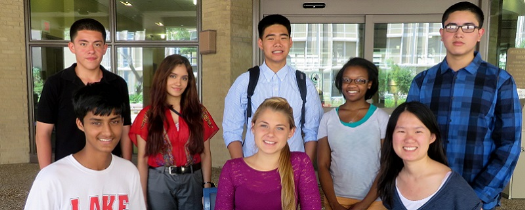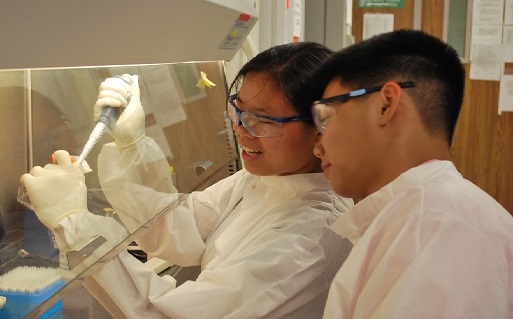 From left to right: Josue Chirinos, Ashok Sankaran, Jennifer Aguilar, Hannah Kelly, Kevin Le, Darah Scruggs, Vivian Tat, and Jesse Martinez were participants in the 2014 High School Summer Research Program
From left to right: Josue Chirinos, Ashok Sankaran, Jennifer Aguilar, Hannah Kelly, Kevin Le, Darah Scruggs, Vivian Tat, and Jesse Martinez were participants in the 2014 High School Summer Research Program
Scott Weaver, scientific director of the Galveston National Laboratory, stands in front of a teaching auditorium in the School of Health Professions and explains the vectors of the chikungunya virus that has recently spread to some parts of the United States. The attentive audience listening to him is not comprised of world-class scientists or news reporters. Eight extraordinary high school students make up the group that eagerly absorbs every word of the famed scientist’s description.
The students are part of a unique program at the University of Texas Medical Branch at Galveston that pairs high school students with scientists who mentor them in ongoing research in their laboratories.
More than 30 years ago, the UTMB School Health Advisory Committee agreed to show high school students around laboratories in response to the students’ excitement and curiosity about science. An outgrowth of that day’s visit was the creation of the High School Summer Research Program. Each summer, students are paid to work in UTMB biomedical research labs on projects ranging from new burn medications to vaccines for tropical diseases. The students also study medical ethics and participate in brown-bag lunch career seminars with scientists from across the university.
“Because the faculty here at UTMB understands it is their responsibility to grow the next generation of scientists, they go out of their way to make the effort and the allowances that let a teenager work in a lab,” says Kathy Tiernan, associate professor, director and one of the original founders of the program.
 Hannah Kelly using polymerase chain reaction (PCR) to replicate segments of a particular DNA sequence
Hannah Kelly using polymerase chain reaction (PCR) to replicate segments of a particular DNA sequenceThis year Jennifer Aguilar, Josue Chirinos, Hannah Kelly, Kevin Le, Jesse Martinez, Ashok Sankaran, Darah Scruggs, and Vivian Tat were the lucky high school students selected from more than 200 applicants. Their research ran the gamut from diagnosing oral cancer with nonlinear optical microscopy to investigating the role of a primary response gene in the prevention of Rickettsia.
Over the years, the program has attracted students from as far away as New York and Michigan. Most students, however, usually come from across the Greater Houston area.
One of this summer’s students, Kevin Le, attends Jersey Village High School in northwest Houston but moved to the island for two months to be a part of the program. Kevin studied in Weaver’s lab where scientists are working on a vaccine for chikungunya.
“Working in Dr. Weaver’s lab has shown me how to apply the skills I learned in AP chemistry to the field of microbiology,” says the rising senior. “The sense of community I feel within the lab tells me that this is definitely the kind of work I want to do in the future.”
This was the second year in the program for recent Clear Lake High School graduate Hannah Kelly, who studied the effect of enteric pathogens in the lab of Sara Dann, an assistant professor in the Division of Infectious Diseases. “This program has shown me the importance of research in the world of medicine,” explains Hannah. “Without research, you don’t have anything to implement.”
Clifford W. Houston, one of the original founders of the program, is associate vice president for Educational Outreach at UTMB, the office that oversees the research program. Houston said “the High School Summer Research Program is one of very few instances where students this young get hands-on experience in a real lab, something that can often be life-changing. When high school students get to be a part of a lab that makes a scientific breakthrough, the perception of scientific research changes from the idea of a boring discipline to that of an exciting field where advances into the future are made.”

“There may be programs like ours elsewhere,” said Houston “but only UTMB gives high school students a chance to experience world-class facilities like the Galveston National Laboratory and affords access to some of the world’s leading scientists in burn research and infectious diseases.”
The high school students actually do not enter the highest-level containment labs in the GNL, but many of their mentors do.
The program has a track record of hosting students who end up at prestigious institutions such as Princeton and MIT. Shelley Xie, one of Weaver’s former students, is a Stanford graduate who spoke at a TEDx conference in 2013. Dr. Richard King, a former UTMB high school summer research student, is now an assistant professor of neurology at the University of Utah after completing his residency at Harvard Medical School.
“The UTMB High School Summer Research Program was where I caught the ‘bug’ of wanting to discover and understand something that no one else in the world knew,” says Dr. Deepak Srivastava, director of the Gladstone Institute of Cardiovascular Disease and professor at the University of California, San Francisco. UTMB offered him his first opportunity to explore science in a laboratory setting. Afterwards, he was convinced that science was his destiny. “The experience was a rush and I was hooked.”